 | « Back to article | Print this article |
It is also difficult to say whether the rate rise would be the first of many (as happened in 1994, for example) or could even be reversed sooner rather than later — if inflation does not rise to two per cent, says AV Rajwade.
If the general consensus is right, by the time this column is published, the US Federal Reserve would have increased its short-term interest rate from a band of 0 to 0.25 per cent, to 0.25 to 0.5 per cent.
This of course assumes that the Federal Reserve Board ignores US Congressman Brad Sherman’s belief that God does not want a rate rise now, but in spring 2016.
(No, he was not joking.) One reason for doubting Sherman’s belief is that the Almighty created the world in six days while the Federal Reserve has been pondering over the issue for the last two years.
More seriously, this would be the first rate rise since 2006 and, assuming it takes place, would signal the official end of the 2007-08 crisis in the mortgage market in the US.
Weighty economists from the International Monetary Fund, World Bank and the Bank for International Settlements have been cautioning for the last few months about the impact the rate rise could have on emerging economies, through both capital flight and a fall of the currencies leading to defaults by corporates having unhedged dollar loans.
Our own central bank announced last week that it is fully prepared for any volatility that may arise in financial markets as a result of the rate rise.
At the time of writing, a rate rise is yet to take place and many weighty commentators are expressing caution in central bank-speak.
Lawrence Summers, the former US treasury secretary, recently wrote in an article that he is “far from confident that there is substantial scope for tightening in the US” (Financial Times, December 7).
It is also difficult to say whether the rate rise would be the first of many (as happened in 1994, for example) or could even be reversed sooner rather than later — if inflation does not rise to two per cent.
As James Bullard, president of the St Louis Federal Reserve, said the previous Monday: “We are concerned about all the variables…The main one is particularly the inflation variable. We have to see if that actually starts to materialise.”
One reason for the pessimism about a rise in the inflation rate is commodity prices, which are continuing to soften.
This apart, the quotations also suggest how the fashions and tools of conducting monetary policy have changed over the last few decades.
Initially the belief was that money supply determined inflation; from this starting point, policy-makers moved to short-term interest rates and “forward guidance” as the principal tools to influence inflation expectations and these, in turn, were supposed to influence inflation itself to change in the desired direction.
Simultaneously, it has become customary to emphasise that future actions will be data-dependent.
In fact, empirical evidence suggests that stock and bond price volatilities have doubled since forward guidance became fashionable.
To give just one example, in 2012 the Federal Reserve forecast a growth rate of 3.4 per cent for the current year; it has since been gradually reduced to 2.1 per cent (data from a column by A Gray Shilling in Bloomberg).
One big imponderable is the impact the rate rise, assuming it takes place, would have on the shape of the yield curve.
In principle, if market participants believe the rise is the first of many, the yield curve would steepen; on the other hand, if the belief is that rates may remain reasonably stable, the impact on the shape of the yield curve would be limited. And, the flatness/steepness of the yield curve is crucial to bond prices — and, hence to the net asset values of bond funds. A few high-yield bond funds are already in trouble in the US market.
Other funds are facing redemption demands from sovereign wealth funds of oil exporters, hit by the sharp fall in oil prices.
Arguably, the probability of a run on bond funds is higher than a crisis in emerging economies in general — that is other than those like Russia, Brazil, South Africa, which are commodity exporters.
Recently, mutual funds successfully lobbied to avoid being labelled systemically important financial intermediaries, which would have led to tighter regulatory prescriptions.
They may well be forced to seek help from monetary authorities if a run develops and liquidity in the bond market evaporates.
But this would be in keeping with the general stance of too many financial intermediaries: “don’t interfere when we are making money, but please rescue us in the event of any problems”.
AV Rajwade is chairman, A V Rajwade & Co Pvt Ltd; avrajwade@gmail.com